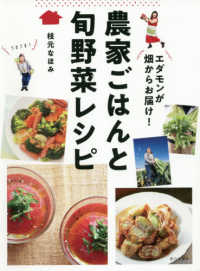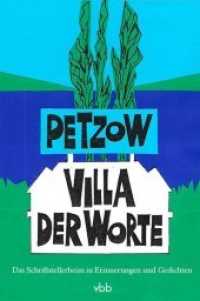- ホーム
- > 洋書
- > 英文書
- > Nature / Ecology
Full Description
A manifesto and a field guide for a new dawn of natural history, practiced by community scientists in their own urban jungle. Imagine taking your smartphone-turned-microscope to an empty lot and discovering a rare mason bee that builds its nest in empty snail shells. Or a miniature spider that hunts ants and carries their corpses around. With a team of citizen scientists, that s exactly what Menno Schilthuizen did one instance in the evolutionary biologist s campaign to take natural science to the urban landscape where most of us live today. In this delightful book, The Urban Naturalist, Schilthuizen invites us to join him, to embark on a new age of discovery, venturing out as intrepid explorers of our own urban habitat and maybe in the process do the natural world some good. Thanks to the open science revolution, real biological discoveries can now be made by anyone right where they live. Schilthuizen shows readers just how to go about making those discoveries, introducing them to the tools of the trade of the urban community scientist, from the tried and tested (the field notebook, the butterfly net, and the hand lens) to the new-fangled (internet resources, low-tech gadgets, and off-the-shelf gizmos). But beyond technology, his book holds the promise of reviving the lost tradition of the citizen scientist rekindling the spirit of the Victorian naturalist for the modern world. At a time when the only nature most people get to see is urban, The Urban Naturalist demonstrates that understanding the novel ecosystems around us is our best hope for appreciating and protecting biodiversity.
Contents
Preface
Part 1: Build Your Own Down House (We can all be Victorian naturalists now)
Chapter 1. The age of the amateur
Chapter 2. Rock vacations
Chapter 3. Darwin @home
Chapter 4. Soup kitchens for science
Chapter 5. Virtual academia
Chapter 6. On Chesil beachcombing
Chapter 7. Dead bug becomes specimen
Part 2: The City Is Your Galápagos (The urban as the naturalist's goldmine)
Chapter 8. Hidden riches
Chapter 9. Nov. spec.
Chapter 10. Urban islands
Chapter 11. Involuntary slaughter
Chapter 12. It's a trap!
Chapter 13. Animal architects of the Anthropocene
Chapter 14. The accidental ecosystem
Chapter 15. On the origin of urban species
Chapter 16. We are a node
Part 3: Knowledge Is Power (The urban conservationist)
Chapter 17. Speak softly and carry a big stick insect
Chapter 18. Tak kenal maka tak cinta
Chapter 19. Let it grow
Closer
Acknowledgments
Notes
References
Index








